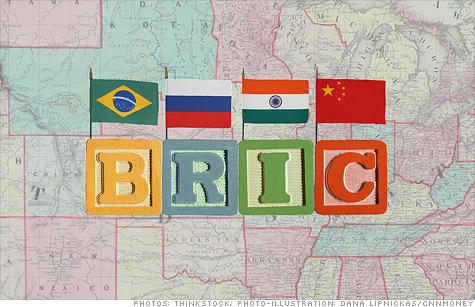Search News

Brazil just cut interest rates for the second time in less than two months. Some think China, as well as Russia and India, may follow suit to try and help the U.S. and global economy.
NEW YORK (CNNMoney) -- Brazil is one of the world's hottest economies. But even it is feeling a need to cut interest rates in response to a slowdown in the developed world.
Despite the fact that inflation is still a major concern in the land of Carnival, Brazil's central bank cut its benchmark Selic rate late Wednesday by half a percentage point.

Rates in Brazil are still a whopping 11.5%, a reflection of the strength of the oil-rich Brazilian economy. But the latest cut comes on the heels of another half-point cut back on August 31. And here's what is most telling. The decision to lower rates was unanimous.
Brazil's Comitê de Política Monetária, or Copom, said in a statement that the move was necessary to promptly mitigate "the effects stemming from a more restrictive global environment."
That's a big change from less than two months ago. The rate cut in August was met with some resistance. Two of the seven Copom members voted against lowering rates. (Richard Fisher and Charles Plosser apparently have friends in Brasilia. How do you say inflation hawk in Portuguese?)
The Greek debt crisis has only gotten worse in the past few months, leading to more calls for quick action in Europe to prevent contagion. And the economic data in the United States, while maybe not hinting at another downturn, is hardly encouraging either.
With that in mind, it makes sense for Brazil to cut rates.
Yes, it has to worry about inflation at home. But it would be foolish to ignore the problems facing some of its key trading partners.
"It is very important to the Brazilian economy that the U.S. and Europe do not slip into another recession," said Otavio Aidar, an economist for Mirae Asset Global Investments in Sao Paulo, Brazil.
However, more rate cuts in Brazil could also help to weaken its currency, the real. That could lead to increased exports from Brazil and more foreign investment there. So it's not as if Brazil is altruistically lowering rates as a way of doing a solid for the U.S. and Europe.
That leads us to China.
The People's Bank of China (PBOC) has hiked interest rates five times since last October. The most recent increase was in July. Some experts fear that China has a real estate bubble brewing that's just like the one that spectacularly popped in the United States.
But China may finally be done raising rates. That's because its economy is starting to lose some steam too.
Sure, China's gross domestic product is still the envy of the planet, rising at an annualized rate of 9.1% in the third quarter. Still, that pace is down from 9.5% in the second quarter and 9.7% in the first.
The inflation rate in China remains an incredibly high 6.1%. But the pace of price hikes are also moderating. At the very least, it seems that future rate hikes from China are unlikely anytime soon -- even if the possibility of a rate cut is open for debate.
That's important to keep in mind considering all the heated rhetoric in Washington about China manipulating its currency and the need for possible trade sanctions.
If China were to lower interest rates, it may not thrill the lawmakers who have been talking tough about China. It could weaken the yuan, which actually has appreciated against the dollar this year because China has raised interest rates while the Federal Reserve has been QE-ing and Twisting to keep rates low.
So big rate cuts in China and Brazil could actually hurt the U.S. and Europe since it could add to the trade tensions.
Then again, you could also argue that anything that might actually lift the value of the dollar wouldn't be a bad thing for the long-term health of the U.S. economy.
As I wrote in a column about the Fed and global interest rates a few weeks ago, "a global coordinated easing effort could be just what the economy needs."
But there's also the issue of commodities. If China, and to a lesser extent Brazil, merely stand pat, that could drive oil, copper and other commodity prices higher again.
Economists at Brockhouse Cooper, a brokerage firm in Montreal, pointed out in a note Thursday that there has been a direct correlation between China rate hikes and commodity prices going down this year.
The reason is simple. The rate increases worked. They helped slow demand. China, because of its heft and ambitious growth plans, has been a voracious consumer of commodities.
"Since China accounts for about 40-50% of the consumption of all base metals, actions by the PBOC do matter for commodity prices," the Brockhouse Cooper economists wrote.
So there's the problem. Rate cuts by China and Brazil do make sense. I think we've all learned that the notion of decoupling, i.e. that the emerging markets can thrive indefinitely as the developed world languishes, is a myth.
If the U.S., Europe and Japan remain in a rut, that's going to hurt the likes of Brazil, Russia, India and China and other developing countries -- especially if they keep rates too high for too long. China's benchmark rate is nearly 6.6%. Rates in India and Russia are 8.25%
"We expect other emerging market central banks to follow Brazil's rate cuts too. Already, almost all emerging market central banks have stopped hiking rates," Aidar said.
But if those nations cut rates to try and stimulate global demand, there will be some consequences.
At the end of the day, rate cuts by Brazil and China may help somewhat, but they are not a magical elixir for the many problems facing the developed world.
"If you are looking for looser monetary policy in China and Brazil to save the U.S. and Europe, it's not going to happen," said Brett Hammond, senior economist with TIAA-CREF in New York.
The opinions expressed in this commentary are solely those of Paul R. La Monica. Other than Time Warner, the parent of CNNMoney, and Abbott Laboratories, La Monica does not own positions in any individual stocks. ![]()
| Overnight Avg Rate | Latest | Change | Last Week |
|---|---|---|---|
| 30 yr fixed | 3.80% | 3.88% | |
| 15 yr fixed | 3.20% | 3.23% | |
| 5/1 ARM | 3.84% | 3.88% | |
| 30 yr refi | 3.82% | 3.93% | |
| 15 yr refi | 3.20% | 3.23% |
Today's featured rates:
| Latest Report | Next Update |
|---|---|
| Home prices | Aug 28 |
| Consumer confidence | Aug 28 |
| GDP | Aug 29 |
| Manufacturing (ISM) | Sept 4 |
| Jobs | Sept 7 |
| Inflation (CPI) | Sept 14 |
| Retail sales | Sept 14 |